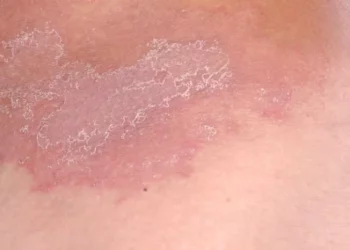When confronted with the term “ringworm,” many conjure images of creepy crawlies burrowing beneath the skin. However, despite its misleading moniker, ringworm isn’t caused by worms at all. Rather, it’s a common fungal infection that affects the skin, scalp, and nails. In this article, we will delve into the origins of the term “ringworm,” explore the fungal culprit behind the infection, and shed light on effective treatments.
The Misleading Name: Tracing the Origins of “Ringworm”
The term “ringworm” dates back centuries, rooted in the belief that the infection was caused by a parasitic worm. Early observers noted the distinctive ring-shaped rash that often accompanied the condition, leading them to coin the misleading term. However, as medical knowledge advanced, it became clear that ringworm was not the work of worms, but rather a fungal infection.
Understanding the Fungal Culprit
The true cause of ringworm lies in a group of fungi known as dermatophytes. These fungi thrive in warm, moist environments and can infect the skin, scalp, and nails. The most common dermatophyte species responsible for ringworm include Trichophyton, Microsporum, and Epidermophyton.
Ringworm is highly contagious and can spread through direct contact with an infected individual or contaminated surfaces such as towels, clothing, and gym equipment. Pets, particularly cats and dogs, can also harbor the fungi responsible for ringworm, making them potential sources of infection.
Unveiling the Symptoms of Ringworm
Ringworm can manifest differently depending on the affected area of the body. Common symptoms include:
1. Skin: Red, scaly patches that may be accompanied by itching and inflammation. The rash often forms a ring-shaped pattern, hence the name “ringworm.”
2. Scalp: Hair loss in circular patches, accompanied by itching and scaling of the scalp. In severe cases, the affected areas may develop painful, pus-filled sores.
3. Nails: Thickening, discoloration, and brittleness of the nails. Infected nails may become crumbly or develop a distorted shape.
While ringworm is typically not a serious condition, it can cause discomfort and embarrassment. Prompt treatment is essential to prevent the infection from spreading and to alleviate symptoms.
Dispelling Common Myths
Despite its prevalence, ringworm remains shrouded in myths and misconceptions. Let’s debunk some of the most persistent myths surrounding this fungal infection:
- Myth: Ringworm is caused by worms.
Reality: As discussed earlier, ringworm is caused by fungi, not worms. The term “ringworm” is a misnomer that persists from centuries past. - Myth: Ringworm only affects children.
Reality: While ringworm is more common in children due to their close contact in schools and daycare centers, it can affect individuals of all ages. - Myth: Ringworm is untreatable.
Reality: Ringworm is highly treatable with antifungal medications. Over-the-counter creams and ointments are often sufficient for mild cases, while severe or persistent infections may require prescription-strength medications. - Myth: You can get ringworm from toilet seats.
Reality: Ringworm is primarily spread through direct contact with an infected person or animal, or through contact with contaminated surfaces. While it’s theoretically possible to contract ringworm from a contaminated toilet seat, the risk is minimal compared to other modes of transmission.
Effective Treatments for Ringworm
The treatment of ringworm depends on the severity and location of the infection. Common treatment options include:
1. Topical Antifungal Creams: Over-the-counter antifungal creams such as clotrimazole, miconazole, or terbinafine are often effective for treating mild cases of ringworm on the skin. These creams should be applied to the affected area as directed until the infection clears.
2. Oral Antifungal Medications: In cases of severe or widespread ringworm, oral antifungal medications may be prescribed by a healthcare provider. These medications work from the inside out to eradicate the fungal infection.
3. Antifungal Shampoos: For ringworm of the scalp, medicated shampoos containing antifungal agents such as ketoconazole or selenium sulfide may be recommended. These shampoos should be used regularly until the infection resolves.
4. Home Remedies: Some individuals may opt for home remedies such as tea tree oil, apple cider vinegar, or garlic due to their antifungal properties. While these remedies may provide temporary relief, they are not a substitute for medical treatment and may not effectively eradicate the infection.
Preventing the Spread of Ringworm
Prevention plays a crucial role in controlling the spread of ringworm. Follow these tips to reduce your risk of infection:
1. Practice Good Hygiene: Wash your hands regularly with soap and water, especially after touching animals or coming into contact with potentially contaminated surfaces.
2. Avoid Sharing Personal Items: Refrain from sharing towels, clothing, combs, and other personal items with individuals who have ringworm.
3. Keep Skin Dry and Clean: Moisture provides an ideal environment for fungi to thrive. Keep your skin dry and clean, especially in areas prone to sweating.
4. Treat Infected Pets: If your pet is diagnosed with ringworm, follow your veterinarian’s recommendations for treatment and disinfect your home to prevent reinfection.
By implementing these preventive measures and seeking prompt treatment for ringworm, you can minimize your risk of infection and enjoy healthy, clear skin.
Conclusion
While the name “ringworm” may evoke images of wriggling worms, the truth is far less sinister. Ringworm is a common fungal infection caused by dermatophytes, not worms. By understanding the true nature of ringworm and dispelling common myths, individuals can take proactive steps to prevent infection and seek timely treatment when necessary. With proper care and treatment, ringworm can be effectively managed, allowing individuals to reclaim healthy, clear skin free from fungal invaders.
























